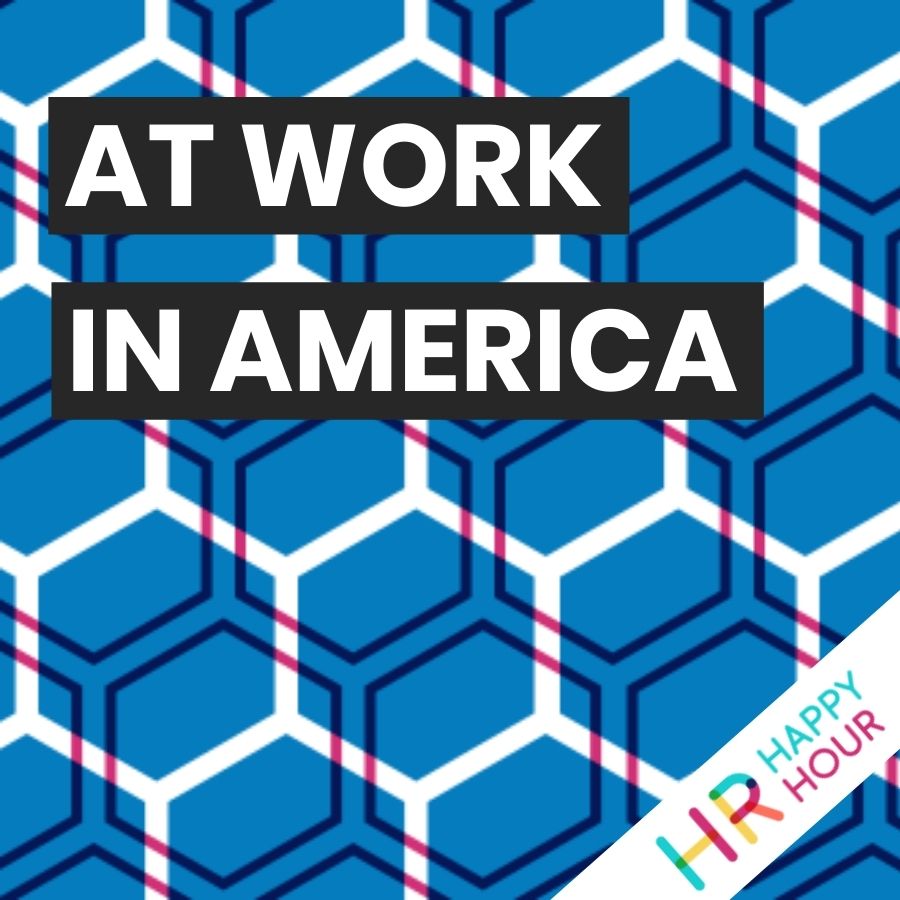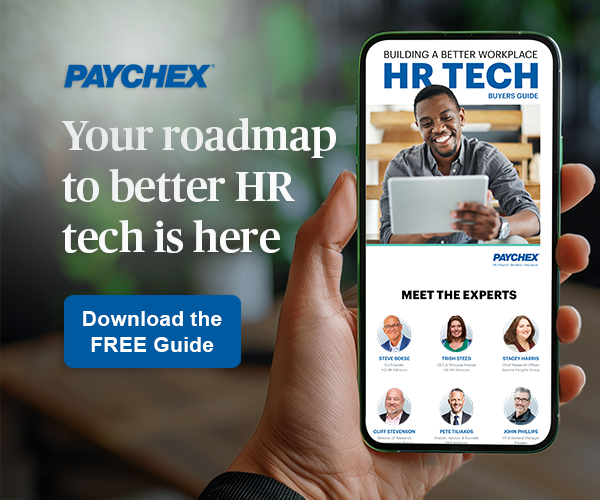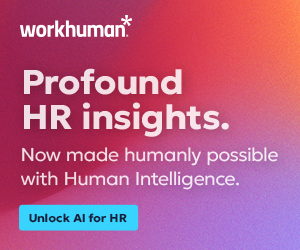Why Should Organizations Include Adoptive Families in Employee Benefit Programs?
Hosted by

Steve Boese
Co-Founder and Chief Data Officer of H3 HR Advisors and Program Chair, HR Technology Conference

Trish Steed
Co- Founder and Chief Strategy Officer, H3 HR Advisors
About this episode
540 – Why Should Organizations Include Adoptive Families in Employee Benefit Programs?
Hosts: Steve Boese, Trish Steed
Guest: Rita Soronen, President & CEO, Dave Thomas Foundation for Adoption
This episode of At Work in America is sponsored by Paychex, one of the leading providers of HR, payroll, retirement, and insurance solutions for businesses of all sizes. The current business and hiring environment has redefined what it takes to succeed as an HR professional, requiring HR leaders to adapt and innovate at lightning speed to help their organizations remain competitive. Download the 2022 Paychex Pulse of HR report to discover the tools and tactics your peers are using to deliver on both HR and business objectives – faster and at scale – while still meeting the evolving needs of their employees. Visit payx.me/PHR2022 to download your copy, today.
This week, we met with Rita Soronen from the Dave Thomas Foundation for Adoption to learn more about how organizations can support adoptive families.
– Why is it important for an organization to offer adoption benefits?
– Data around adoption rates and companies that offer adoption benefits
– Types of benefits that can help employees going through the adoption process
– Steps to take when implementing adoption benefits into your existing parental leave program
For more information, click here
Thank you, Rita, for joining the show today! Remember to subscribe to At Work in America wherever you get your podcasts.
Transcript follows:
Announcer 0:24
Welcome to At Work in America sponsored by Paychex. We welcome a wide and exceptionally impressive array of guests, business leaders, HR leaders, academics, practitioners, consultants and authors to talk about the most timely, relevant and challenging issues that are influencing the workplace today. At Work in America digs in behind the headlines and trends to the stories of real people making a difference in the world of work. And now here are your hosts, Steve Boese and Trish Steed.
Steve 0:57
Welcome to the show today, we have a great show today, Trish, on a topic that you just clued me in to – 13 plus years of doing this show, we literally have never talked about this before.
Trish 1:10
I know, I’m excited. It’s something also that’s just very in the moment and very forward thinking. So I love everything about the topic.
Steve 1:18
Yeah, today’s topic is about adoption and how organizations can support their employees, parental families, and how parental leave programs can support adoptive families, more comprehensively better, and maybe maybe if they don’t support them now, why they should. We’ve got a great guest today, who we’re going to welcome here in a second. Before we do Trish, I want to thank our friends at Paychex. They’re just so wonderful to us and have been for a while but this episode of At Work in America is sponsored by our friends at Paychex, one of the leading providers of HR, payroll, retirement and insurance solutions for businesses of all sizes. The current business and hiring environment has redefined what it takes to succeed as an HR Pro, requiring HR leaders to adapt and innovate at lightning speed to help their organizations remain competitive. You can download the 2022 Paychex Pulse of HR Report to discover the tools and tactics your peers are using to deliver on both HR and business objectives faster and at scale, while still meeting the evolving needs of their employees. Please visit payx.me/phr2022 to download your copy today and we will put that link in the show notes. All right thank you to our friends at Paychex.
Steve 2:32
First let’s welcome our guest today. We are honored and pleased to be talking to Rita Soronen. She is the President and CEO of the Dave Thomas Foundation for Adoption and we’ll be talking about the importance of including adoptive families and parental leave programs. For more than 30 years, Rita has worked on behalf of abused, neglected, and vulnerable children, providing leadership for local state national efforts working to improve the juvenile justice and child welfare systems. While striving to ensure safe and permanent homes for North America’s children, leaving the Dave Thomas Foundation for Adoption, which is a national nonprofit public charity since 2001 and the Dave Thomas Foundation for adoption Canada since 2004. She works to find adoptive families for more than 150,000 children waiting in North America’s foster care systems. Under her leadership, the foundation has significantly increased its grantmaking while developing strategic initiatives that act on the urgency of this issue. Rita, welcome to the show. Thanks for joining us today.
Rita Soronen 3:35
Listen, Steve and Trish, I am so excited to be here. Thank you for having me.
Steve 3:39
It’s our pleasure. This is a big issue. As Trish said it’s very it’s timely but it’s always been important. That number 150,000 children in the foster care system, I’ll admit to sadly to not realizing it was that many.
Rita Soronen 3:54
Yeah, and that’s United States and Canada. And those are children who have been freed for adoption. And remember, children come into care because they’ve been abused or neglected or abandoned or they’re through no fault of their own. And right now is we’re talking there about 400,000 children in America’s foster care system, who are in this sort of indeterminate status. Hopefully, they will go back to their families. But for about 117,000. Those are the children in the United States in particular, for whom the abuse has risen to such a level, the courts have finally done what they don’t like to do and terminate parental rights. So those children are simply waiting to be adopted.
Trish 4:31
Thank you for that. Are those children of all ages, I would imagine then?
Rita Soronen 4:36
They are and particularly the children waiting to be adopted birth to 18. But the average age of a child waiting hovers between around eight or nine. So it’s an older child in foster care waiting for an adoption.
Trish 4:48
And such critical years, right. And so if you’ve already been through quite a bit to get to that point of needing an adoption, it’s even more critical, I would imagine for those.
Rita Soronen 4:57
Exactly. They’ve experienced layers of trauma. They’re experiencing grief and lost all of those things that quickly they need a home.
Steve 5:04
Yeah, I know that there’s a story you want to share with our listeners about a pair of siblings named Lexi and Nick from Ohio. But before we get to that story, just for folks who may not heard of the Dave Thomas Foundation prior to the show, mainly because I think it’s been around for quite some time, but certainly the fame and notoriety of the founder Dave Thomas himself for other reasons. But for folks who are not familiar with the Dave Thomas Foundation, can you give us just a little bit of the origin story of the foundation, sort of how it started, and maybe even why it started?
Rita Soronen 5:38
Of course. Dave Thomas, as you noted, was not only the founder of the Dave Thomas Foundation for adoption, but of the Wendy’s company, that brand that sells square hamburgers and Frosty’s right?
Steve 5:48
So good, by the way.
Rita Soronen 5:51
We’re wholly independent from the company, but we are their chief philanthropic beneficiary of their franchisees and the corporation. So when Dave Thomas was getting toward really the end of his active role as the CEO of the company, really wanted to put in place what was embedded in Wendy’s DNA, which was giving back to the community, how could they do that at a different, bigger, better level. And so they really decided to form this independent foundation that could address a social issue. What folks may not know is that Dave Thomas was adopted. And although he spent just a small amount of time in foster care, he was adopted as an infant. His adoptive mother passed away when he was young, he was raised by his grandmother because his father was a bit of an itinerant worker moving from place to place. And Dave Thomas actually left home at age 16, struck out on his own and the rest is kind of history. Well, what he understood is that’s fairly unique that no child should have to what pull themselves up by the bootstraps, even though he understood the value of family, he had family. He also had a challenging situation, which is, quite frankly, what many of our teens in foster care experience. So he really settled on how can we elevate this cause of adoption, but specifically foster care adoption, because in 1992, it was not a robust conversation in this country. myths and misperceptions surrounded children, the system, people were unsure and there was a default, typically, when families were thinking of adoption to domestic infant or domestic international adoption. So he really thought the time in place was important to begin to focus on those vulnerable children and families and foster care and see if this foundation could perhaps make some changes. So we are we are honored every day to carry on that incredible vision and legacy of Dave Thomas. I know most people in the business think his legacies is the Wendy’s company. And indeed, it is a phenomenal brand. But we like to think of the foundation as his dual legacy.
Trish 7:52
Thank you for sharing that story. Certainly one that I was not aware of. I wonder is that something? I mean, obviously, we kind of alluded to the fact that these children who were in foster care and are at the point of being available for adoption, is there any sort of information about sort of his his life’s journey, his successes that he really helped make himself? I mean, is that part of kind of the foundation’s role with these young people and sort of inspiring them to sort of strive for more or hang on?
Rita Soronen 8:26
Exactly. It’s it’s sort of a mixed message, because we want to make sure that people understand this legacy. It’s an incredible story. And I know the, the Wendy’s company, Wendy’s website has this whole timeline of of the business related as well as the foundation related activities that people can refer to, and I think it’s just Wendys.com. But there’s also this message of Yes, look, let’s keep hope in this picture, because it’s such a complex issue of family violence, of poverty, of substance abuse of all those, those societal issues that we haven’t quite figured out yet that weave in and out of these children’s and families lives. But underneath that all I think, is that message of hope, right? Not that you should be have to excel and create a fortune 500 company to to prove that adoption is a good issue or that you’re a good person. But I think embedded in that is this notion of there is hope that this isn’t a hopeless cause that that we can do something different on behalf of children and families.
Steve 9:29
Thank you for sharing that. I think one of the things I think that helps me and I imagine helps other people too, is to kind of put some, if not faces, at least names to some of these stories. And I know that prior to the show, the team shared with us some background on one particular story of a pair of siblings from Ohio named Lexi and Nick. Could you maybe tell a little bit of that specific story because I think that’s hopefully representative of the opportunity And the good that can happen here, right? Facilitated, certainly by the great work that you and the team do there.
Rita Soronen 10:06
Absolutely. And it is really, in a way a symbol of who these children are in care. This is a sibling group Lex and Nick, where two siblings who were finally found in a hotel room and listen at age nine and six, they were found in this hotel room by parents substance abuse issues where they’re looking no parent intent, most parents don’t intend to hurt their children. But there is this this insidiousness about substance abuse that makes adults do things that they wouldn’t have otherwise done, right. And so they were there they had been abandoned. And the the compelling story here is that Nick was older than Lexie, Nick was about nine Lexi was about six. But because Nick had some some health issues, it was the younger child, it was Lexie, who was taking care of her older brother. So imagine six year old taking care of a nine year old on their own trying to figure out, you know, basics and the basics, food and survival. They were found there. They were put in foster care.
Rita Soronen 11:06
They stayed in foster care for eight years. And that’s part of the challenge that the foundation is starting is trying to address is that children all right, if it’s Foster Care is a safe place, but it should be a temporary safe place. Children should not grow up in foster care. But there are certain segments of populations of children’s sibling groups, teenagers, children with special needs that don’t quickly get adopted because of simply their circumstance. But the good news is because of the work of us signature program of the Dave Thomas Foundation for adoption, Lexi and Nick were adopted at age 14 and 17 as a sibling group together. And today, one of them is in college, Nick is in college and Lexi is on the way to move into college. So it’s a success story, it’s a good story. Embedded in that is that notion of we have to do better for children, we can’t let them linger in foster care. We can’t think that because they’re may have special needs or their sibling groups or their teenagers, that they’re any less viable for a family that they’re any less deserving to live in a family. And so I think that’s the power of this story. And, so many of the stories that we have of children that we’ve helped move to adoptive homes.
Trish 12:15
What a profound story, I think, you know, it’s like Steve said, it’s when you know, sort of a name, or even a face that you can put to the real issue at hand that really sort of starts touching people’s hearts. Can you maybe talk about some of the the ways that organizations are working with you to start touching the hearts of their employees maybe and making that that journey, whether it’s to be a foster parent, or ultimately an adoptive parent? What is that bond that you have with the organizations that are starting to work with you or that have worked with you in the past?
Rita Soronen 12:50
No, it’s a great question. And we do a number of programs that not only aggressively through a grant program move children from foster care to adoptive homes, but we have to figure out a way to support families who do step forward to adopt or to encourage this conversation about adoption, particularly in the workplace, right? Millions of folks spend their day in some way in a workplace, and what a great opportunity to think about these kinds of conversations. So, again, Dave Thomas, very organically began a program, while he was still very vibrant as a CEO, talking to other CEOs and saying, Hey, if you offer a benefits to families that are formed through birth, do you also offer some kind of benefits to families that are formed through adoption, and it was a unique conversation at that point, because, of course, birth is a health care issue. And so we want to make sure that appropriately employers can can support families during during pregnancy and childbirth. But the same needs exist for adoptive families time to bond time off financial issues, if they’re adopting. And so he began again, very organically.
Steve 13:59
Even just hovering those adoptive children in the normal kind of suite of health benefits that the organization offers the employees and their other dependents.
Rita Soronen 14:08
Exactly, exactly. And so he began this conversation of you can put benefits in the workplace, you can provide financial assistance to families who adopt, you can provide paid leave to families who adopt, you can provide unpaid leave over and above if you’re an FMLA required organization over and above the 12 weeks required by FMLA. And although our conversation is foster care adoption, this should apply to all families who adopt because there are different costs embedded in infant domestic or infant international versus foster care adoption. There are different time constraints perhaps for a family that is adopting an infant versus a family that’s adopting a sibling group of three, two of whom are teenagers, right? And so really began this his program that we’ve extended now and it’s called the adoption friendly workplace campaign where we encourage employers to put these benefits in place And in fact, a number of years ago started the 100 best adoption friendly workplace list. To encourage, we know employers like to be on best lists, right? And so it was, it was a bit of a hook for us to say, get on our best lists, show yourself off, and encourage others to do the same. Now we’re not talking about every employer can’t do the same as every other employer can so assess what your budget can can allow, what do your employees need? And then think about putting these benefits in, in the workplace, then it’s become wildly successful, and it’s a growing trend in this country.
Trish 15:36
I wonder if it’s partly because the generations that are coming up are more open to talk about these things I’ve some of the notes I’ve been making, as you’ve been been talking so far is just that. It seems like a lot of the reasons that these children end up in foster care to begin with are things that we maybe if you’re a Gen X, or boomers, we don’t really talk about these things, right. We’re sort of raised, you keep anything that might be happening in your household that is not viewed as ideal, right? It’s private. So I think that’s maybe part of it. Or also, you know, Steve said, a lot of people, we haven’t even heard of this as an option. And my last point would be, you’ve mentioned about affordability of this. So I guess my question is, when you’re, if your organization doesn’t have something like, like foster care, adoption benefits in place, or you’ve not considered it? How do you start having that conversation? When it might be something that, you know, as leaders, we’re not prepared to even have we might not have ever had these conversations before? What kind of guidance would you give to me? If I’m a CEO of a company considering this?
Rita Soronen 16:47
It’s a great question. And first and foremost, underscoring all of this knowing that it can be complex for a place of employment. To think about this, for the first time, we’ve created a comprehensive toolkit that folks can find on the Dave Thomas Foundation website. For employers, here’s everything you need to know, here are other places you need to check out to get more information. But that aside, I think the first step is really survey your employees understand what their needs are, and particularly now with the great resignation that’s happened across and this the ability to recruit and retain quality employees. I think understanding what some employee needs is, is really a first the first step and then talk to similar companies, similar sized companies, we’ve got lists of companies that do provide employee benefits, and we’re always happy to make those matches. So you can you know, what were the challenges? What were what has been the benefit of adding this to an employee menu of benefits? really talk about what policies will need to be put in place, assess your budget, what can it what can we afford? The reality is we know that pretty much 1/10 of 1% of employees take advantage of these benefits. So it’s a it’s a high impact, low low cost benefit to employers, what they have to communicate that it exists, we don’t want them to hide it either. And we don’t want them to say, Oh, we’ve got this benefit, but we don’t want anybody to use it. That’s not the the tone that we’re trying to take here. And then you just begin to craft this adoption Assistance Program. And you have to determine things like Well, who would be eligible among our employees? Is it full time employees, part time employees? Can it can you that take advantage of it from the day you were hired? Or do you have to have been employed for a period of time? How much will we provide?
Rita Soronen 18:29
Well, we provide financial assistance and how much? How much leave? Will we provide? And will it be paid or unpaid or potentially both? What’s the process for asking for reimbursement if we if we determine that we’re going to provide financial assistance? What are the types of adoption we’ll cover? Typically, all adoptions, domestic infant international foster care covered the ones that aren’t our step parent adoptions because there’s relatively no cost implied in those and and it tends to be more of a family bonding situation rather than an outside of experience. But you know, a step or grandparent adoptions are becoming increasingly important. And so will you cover a grandparent or a candidate option as well? Will this be retroactive if for example, you start this in 2023? Anybody that adopted in 2022, will they be able to take advantage this? So you have to think through all of those things, but we can certainly help with that. And then begin if once you do think about implementation, you know, obviously consult with tax attorneys consult with the IRS, what are the implications for the business? But the reality is, this is really easy. It’s one of the easiest benefits to put in place. And what it does provide is this payback to the company it it engenders, we know from the companies we talk to, it engenders a sense of loyalty, a sense of equity among employees, if there are benefits for birth, and you provide benefits for me as an adoptive parent. I feel much better about you as an employer, we also know that it provides a competitive edge. And particularly now, again, if if one employee is looking at two companies, pretty much everything else is equal. But as they drill down into the benefits package, I have robust adoption benefits, I just get a sense of that employer as a family friendly place that I might be interested in working. So I think all of those things are important to think about when you’re beginning to put it in place. But again, I can’t stress enough, we’ve got this toolkit and access to other employers, so that you really don’t have to start this from scratch. Don’t have to think about this in a vacuum.
Steve 20:39
Yeah, I mean, thank you for that. That was a very good, comprehensive kind of overview of the things we want to be thinking about, and organizations need to think about. And I think you’re also running into an important trend is the right word. But we you know, we do lots of these shows, we talk about lots of workplace issues and topics and one of the things certainly that’s, I think, then raised an importance for employers, maybe it was a COVID thing, or maybe it was going to happen anyway, is really employers really looking to embrace more of the overall call it well being but in Can’t you know, their employees and compensating not just health benefits, but mental or physical health, but mental health, work life balance, like holistic approaches to supporting people with the kind of support they need, whether it’s remote work, or hybrid work, or go live where you want to sabbaticals, you name it, there’s been so many things that have happened in the last few years. I think some of it in response to COVID, and all the pressures that that societies and families were under just because of health concerns, and others. But I think this fits into that too, like as an organization to approach this topic and say, we’re going to be the organization that supports all of our people in the ways that they would like to have support or would would desire support. And I think you’re absolutely right about fostering more inclusivity more loyalty, and just kind of and not for nothing kind of doing the right thing. You know, I think that must count for something as well.
Rita Soronen 22:08
It does. It counts for a lot, I think that do the right thing in particular, given that the diversity of families exist within the workplace environment. And that look, adoption was shrouded in secrecy, not so long ago, typically, because of that infant birth, and an unwed mother and all of the shame that was clothed on families that were in that circumstance. And when you think about it, it just wasn’t that long ago. And so we’re bringing out to this notion of it’s not something to be ashamed about, it’s something to be celebrated. It’s something. So if we have parties, for families that are about to give birth, we should have parties for families that have completed or are about to complete an adoption, it’s just again, bringing that a different a different cloak of sensibility about this conversation. And you’re right for those those now, younger employees coming into the workplace, they do want to be connected to a cause they want to see that their employer is connected to a cause that perhaps they can latch on to. And so this notion of foster care adoption and children waiting there in their community to be adopted, the adoption friendly workplace is a nice segue into that conversation.
Trish 23:14
Yeah, I would imagine to just in my time, in HR, I had worked with employees who, of course, had gone through some of the other types of adoptions you’re talking about. But I wonder to the employees that we had that were going through maybe infertility issues, and they were getting to the phase a year or two, and maybe they were starting to consider adoption, it would have been nice if our organization would have had maybe more information about adoption through being a foster parent first. And I don’t recall ever having that conversation. So it’s sort of exciting to me to think about, wow, if I’m sitting in human resources, and I have someone because they do come to you sort of like a therapist, you know, incompetence and telling you sort of the things we’re dealing with. And if someone were coming to me, I would for sure now say Have you also considered foster care adoption, as maybe a way to do that. I think the other thing that really struck me is when you’re talking about celebrating versus being ashamed is that you’re right. We do have baby showers for people who are expecting and and even if you adopt a baby, often that’s sort of celebrated. But wow, can you imagine just back to your original story, if I’m adopting a 14 year old and a 17 year old? Wouldn’t it be wonderful to have sort of a child shower teenager shower, right, because the challenges are immense. Oh, I’m just sitting here with the wheels turning so I just wonder if, if other listeners who are in human resources or maybe their CEOs or owners of companies were thinking about it in that way, like, it really seems like such a way to give give ideas back to your employees as well, right, you’re providing a benefit, but you’re also maybe giving them an alternative to an issue that they’ve been struggling with that they hadn’t yet considered.
Rita Soronen 25:12
You so right and and it also opens that door to opportunities. So that at once, you know, in September when school starting employees can gather and maybe fill up backpacks for kids in foster care that need extra school supplies, because foster families don’t have a lot of disposable income, or at holiday time, again, helping families who have adopted perhaps a sibling group of two or three and need just a little bit of assistance with some gifts, you know, and so it gives this opportunity for community exchange, but also internal opportunities, just networking opportunities for families who have adopted in the workplace, they can connect and network and talk to each other and share challenges and joys, educational opportunities about all forms of adoption, including foster care adoption, so it just opens the doors to other kinds of internal activities as well.
Trish 26:03
Yeah.
Steve 26:05
I have one more question sort of related to kind of organizational support for adoptive families foster adoptive families as well is, do you find over time as organizations embrace these types of benefits? Or support them a little bit more completely? Or fully? Does that move the needle? Do do we see an increase in adoptions or at least an increase in interest in foster adoptions? Like, kinda Can you point to some UI here, we can kind of we should we can show this, this does help. This does help kids.
Rita Soronen 26:37
It does help. Because I think, again, unless you’re actively involved in the child welfare system, either as a volunteer or as someone that has been involved for some reason, it’s not a conversation we talk about. So it, it begins to highlight that, look, the need for this is in every community, the need for foster parents to step forward, the need for volunteers to step forward, the need for adoptive families to step forward. And so once that’s, there’s a light shining on that need. It does drive people to consider calling their adult local adoption agency and volunteering, or saying how do I begin to think about fostering I can’t adopt right now. But I’d be absolutely interested in taking in a child that needs a temporary home. We’ve seen it happen time. And again, that as that as that as that door is opened into the conversation, the interest grows, and then we can connect or the or the organization, the employer can connect folks to community organizations, and they do they see an increase in at least interest, if not activity.
Trish 27:38
Yeah, one of the things you know, when you’re thinking about potentially being a foster, a foster parent, who then might go down the road of adopting those foster children or other foster children is, I don’t know, maybe I can’t afford this, or I’m not good enough, or my home’s not good enough. What would you say to maybe someone who’s just kind of considering it, but not that certain that they’re qualified or good enough? What kind of support can someone like that have down that path of either foster care or foster to adoption?
Rita Soronen 28:11
It is really an open field for folks to step forward and adopt, you don’t have to be wealthy, you don’t have to own your own home, you can be single, you can be in a same sex relationship, you can be an older folks person, you know, you may have already raised children, and you don’t really want infants in your house again, but you’d be willing to bring an older child into your home. So that door is wide open, but you do have to go through certain educational requirements, you do have to have a home study to make sure your home is physically safe for a child typically go through a background check. But again, just about anybody that’s interested, can can go through those steps and certainly learn if they can qualify and, and the qualifying bar. I don’t mean to say this in the way that it sounds. But again, you don’t have to be wealthy, you don’t have to have your own home, you don’t have to you don’t have to be what you may think you have to be and so are self selecting out of that process.
Trish 29:06
Thank you for sharing that. Because I would imagine people probably do self select out for those reasons. And if you think about just being a parent in general, there are parents of every background, right? Parents have every socio economic status. And so why wouldn’t we expect the same for foster parents as well. It’s more about taking in a child and loving that child and giving that child a better home life and a better surroundings, right, a more stable home life, then probably anything financial, I would imagine.
Rita Soronen 29:39
And there are financial supports, particularly in foster care that follow these children and and fostering so that the State of the County provides funds to help support this child post adoption. There are subsidies that follow most of the children that are adopted from foster care their adoption tax credits for any family who adopts there are some qualifying limits of The income but there are adoptions federal and frequently state adoption tax credits. So they’re and for folks that adopt older youth from foster care, many states have educational vouchers and waivers, because they know you haven’t saved for 18 years to send a child to college. So lots of those financial incentives or supports exist. But I think adoption friendly benefits of financial supports, paid leave, and many businesses are adding foster care supports as well in their package so that if you’re a foster parent, may provide some, you know, paid or unpaid leave in order to do the kinds of things that you need to do take children to appointments, take them to the agency, take them to court, whatever it is you need to do.
Steve 30:42
Yeah, absolutely. This has been so informative and kind of inspiring, I think, for me, and hopefully, for other folks. So, of course, we want to thank you for taking some time to share the story of the Dave Thomas Foundation, some of the stories of of the children that that you and your organization are helping with a lot of other help as well from foster parents and adoptive families, etc. It does. I guess they say it takes a village right. That’s the expression right. And I think we’re learning it certainly does. For folks who want to learn more about either some of the employer the toolkit, you mentioned Rita or just how to get involved. I’m imagine you you won’t turn away donations to the cause, etc, etc. Where to where would we like to direct folks?
Rita Soronen 31:23
The best first place is our website, DaveThomasFoundation.org. And then you can quickly access where the adoption friendly workplace campaign is, how to donate, get how to get more information. We also have an 800 line that it’s answered during business hours, and we’re on Eastern time. It’s 1-800-Ask-DTFA for Dave Thomas Foundation adoption. And you know, we just say our founder said these children are not someone else’s responsibility. They’re our responsibility. We’re so grateful when people just want more information, want to step in and help and assume some of that responsibility as well.
Steve 32:01
Awesome. Great. Thank you so much, that’s Rita Soronen. And she is the President, CEO of the Dave Thomas Foundation for Adoption. A great topic and important topic. One that’s always been important. It’s probably more important today than than it’s ever been. So we please do encourage folks to check out what Dave Thomas Foundation is doing and get involved. And again, Rita, thank you so much for being our guest today.
Rita Soronen 32:23
Thank you for having me. It was my pleasure.
Steve 32:25
All right. Just great stuff. I love it. Great subject. I thought the show we did a couple of weeks ago with St. Jude Children’s Hospital Cancer Center was like inspiring this one. So they’re equally inspiring. We’re, I’m glad we’re getting to talk to some wonderful people doing some really, really important work in their communities. So good stuff, so loved it.
Trish 32:46
I agree. And when Rita, see she knows how to touch your heart, because like Rita, I have twins that are going away to college next week. And so I’m like, I’m sort of like the kids call me “Momma T” around here. All the teenagers. I’m like, Ooh, maybe I need a foster teenager. I would love it!
Steve 33:07
Check that out. All right, well, great stuff. We’ll put all the links that we talked about in the show notes. We encourage folks to check it out and connect with the Dave Thomas Foundation. And thanks Rita. Trish, thanks to you. Thanks to our friends at Paychex for all their support. My name is Steve Boese. We will see you next time and bye for now.
Transcribed by https://otter.ai
Talk to us
If you want to know more about any aspect of HR Happy Hour Media Network, or if you want to find out more about a show topic, then get in touch.










